HONDA CIVIC COUPE 2002 7.G Owners Manual
Manufacturer: HONDA, Model Year: 2002, Model line: CIVIC COUPE, Model: HONDA CIVIC COUPE 2002 7.GPages: 319, PDF Size: 5.02 MB
Page 261 of 319

When reporting your collision to the
insurance company, tell them you
want genuine Honda parts used in
the repair. Although most insurers
recognize the quality of original
parts, some may try to specif y that
the repairs be done with other
available parts. You should investi-
gate this before any repairs have
begun.
Takeyourcartoyourauthorized
Honda dealer f or inspection af ter the
repairs are completed. Your dealer
can make sure that quality materials
were used, and that corrosion-
preventive coatings were applied to
all repaired and replaced parts.
Body repairs can af f ect your car’s
resistance to corrosion. If your car
needs repairs af ter a collision, pay
close attention to the parts used in
the repair and the quality of the
work.
Make sure the repair f acility uses
genuine Honda replacement body
parts. Some companies make sheet
metal pieces that seem to duplicate
the original Honda body parts, but
are actually inf erior in f it, f inish, and
corrosion resistance. Once installed,
they do not give the same high-
quality appearance.
Body Repairs
Appearance Care262
Page 262 of 319

This section covers the more-
common problems that motorists
experience with their vehicles. It
gives you inf ormation about how to
safely evaluate the problem and what
to do to correct it. If the problem has
stranded you on the side of the road,
you may be able to get going again.
If not, you will also f ind instructions
on getting your car towed.......................
Compact Spare Tire . 264
....................
Changing a Flat Tire . 265
..........
If Your Engine Won’t Start . 271
Nothing Happens or the StarterMotor Operates Very .....................................
Slowly . 271
The Starter Operates ................................
Normally . 272
................................
Jump Starting . 273
............
If Your Engine Overheats . 275
.........
Low Oil Pressure Indicator . 278
..........
Charging System Indicator . 279
.......
Malf unction Indicator Lamp . 280
.......................
Readiness Codes . 281
...............
Brake System Indicator . 282
..................
Closing the Moonroof . 283
..............................................
Fuses . 284
..........
Checking and Replacing . 285
......................
Emergency Towing . 290
Taking Care of the Unexpected
T aking Care of t he Unexpect ed263
Page 263 of 319
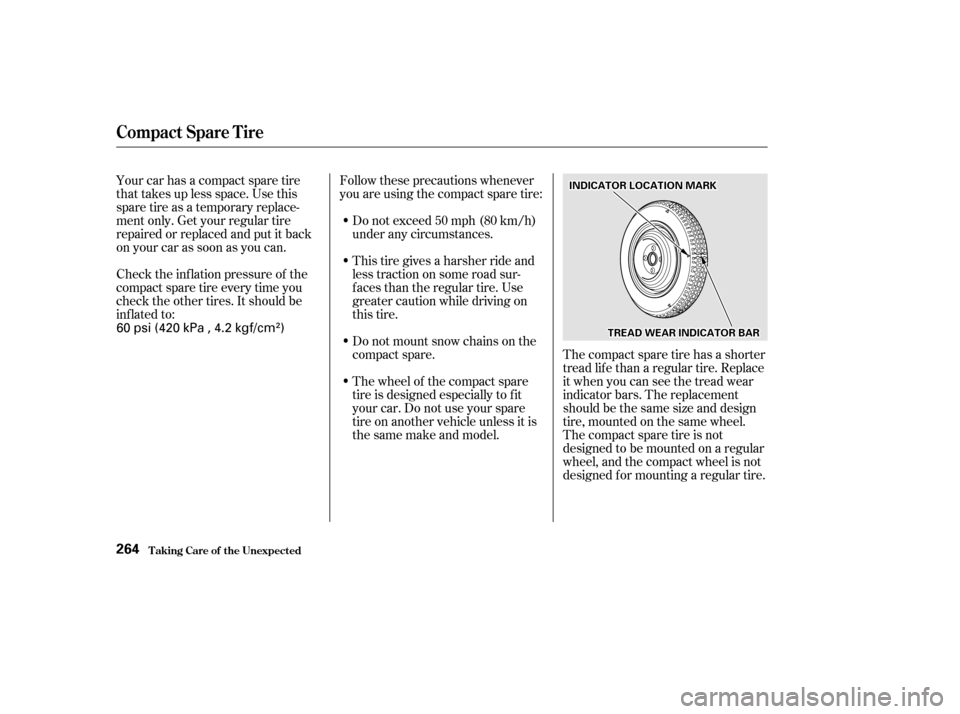
Follow these precautions whenever
you are using the compact spare tire:Thecompactsparetirehasashorter
tread lif e than a regular tire. Replace
it when you can see the tread wear
indicator bars. The replacement
should be the same size and design
tire, mounted on the same wheel.
Thecompactsparetireisnot
designed to be mounted on a regular
wheel, and the compact wheel is not
designed f or mounting a regular tire.
Check the inf lation pressure of the
compact spare tire every time you
check the other tires. It should be
inf lated to:
Do not exceed 50 mph (80 km/h)
under any circumstances.
This tire gives a harsher ride and
less traction on some road sur-
f aces than the regular tire. Use
greater caution while driving on
this tire.
Do not mount snow chains on the
compact spare.
Your car has a compact spare tire
that takes up less space. Use this
sparetireasatemporaryreplace-
ment only. Get your regular tire
repaired or replaced and put it back
on your car as soon as you can.
The wheel of the compact spare
tire is designed especially to f it
your car. Do not use your spare
tire on another vehicle unless it is
thesamemakeandmodel.
Compact Spare Tire
T aking Care of t he Unexpect ed264
IINNDDIICCAATTOORRLLOOCCAATTIIOONNMMAARRKK
TTRREEAADDWWEEAARRIINNDDIICCAATTOORRBBAARR60 psi (420 kPa , 4.2 kgf/cm)
Page 264 of 319
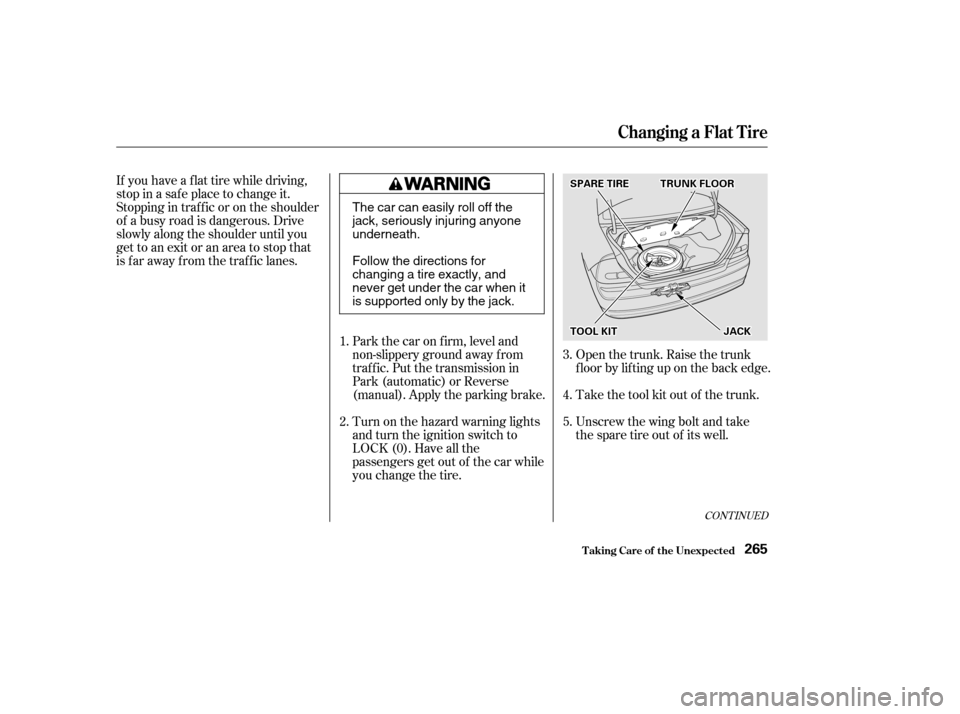
If you have a f lat tire while driving,
stop in a saf e place to change it.
Stopping in traf f ic or on the shoulder
of a busy road is dangerous. Drive
slowly along the shoulder until you
gettoanexitoranareatostopthat
is far away from the traffic lanes.Open the trunk. Raise the trunk
f loor by lif ting up on the back edge.
Take the tool kit out of the trunk.
Unscrew the wing bolt and take
the spare tire out of its well.
Park the car on f irm, level and
non-slippery ground away f rom
traffic. Put the transmission in
Park (automatic) or Reverse
(manual). Apply the parking brake.
Turn on the hazard warning lights
and turn the ignition switch to
LOCK (0). Have all the
passengers get out of the car while
you change the tire.
5.
4.
3.
2.
1.
CONT INUED
Changing a Flat T ire
T aking Care of t he Unexpect ed265
SSPPAARREETTIIRREETTRRUUNNKKFFLLOOOORR
TTOOOOLLKKIITTJJAACCKK
The car can easily roll off the
jack, seriously injuring anyoneunderneath.
Follow the directions for
changing a tire exactly, and
never get under the car when it
is supported only by the jack.
Page 265 of 319
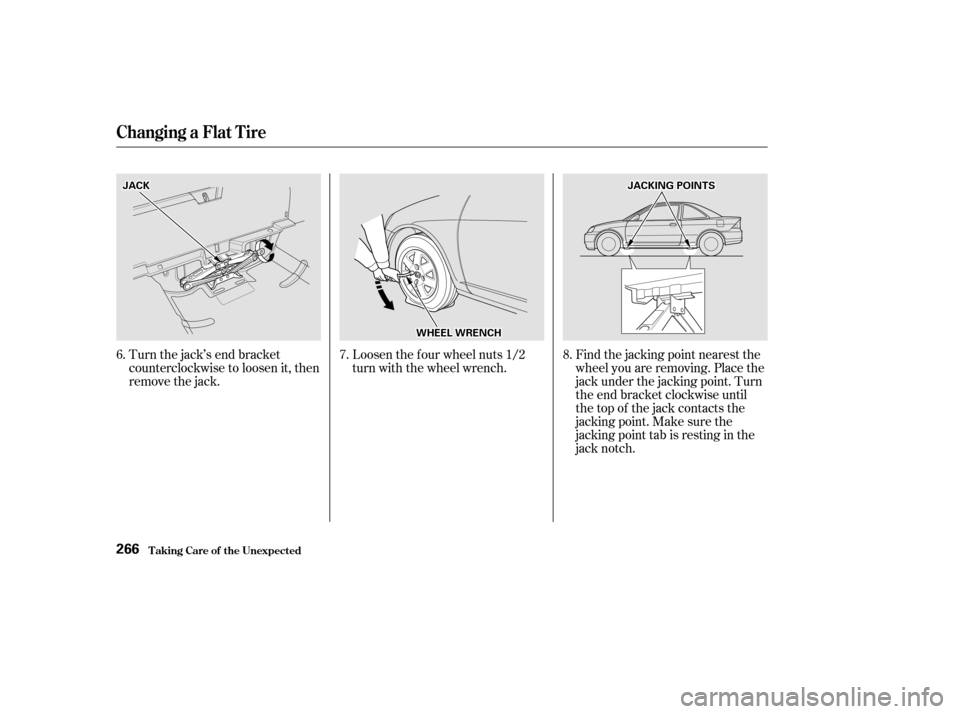
Turn the jack’s end bracket
counterclockwise to loosen it, then
remove the jack.Loosen the f our wheel nuts 1/2
turn with the wheel wrench.
Find the jacking point nearest the
wheel you are removing. Place the
jack under the jacking point. Turn
the end bracket clockwise until
the top of the jack contacts the
jacking point. Make sure the
jacking point tab is resting in the
jack notch.
6.
7.8.
T aking Care of t he Unexpect ed
Changing a Flat T ire
266
JJAACCKK
WWHHEEEELLWWRREENNCCHH
JJAACCKKIINNGGPPOOIINNTTSS
Page 266 of 319
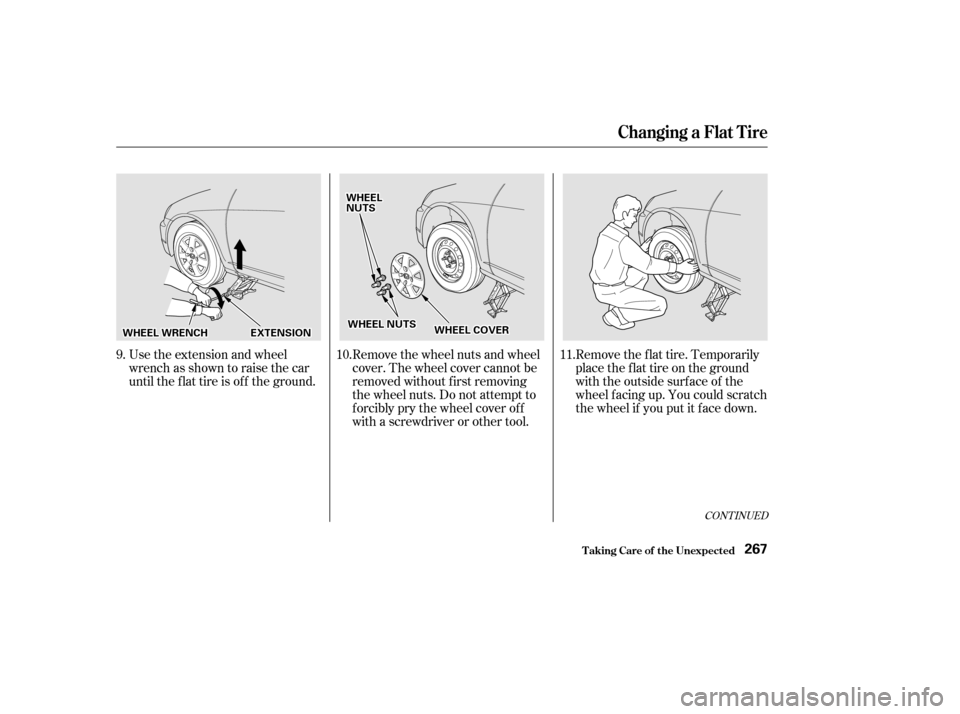
CONT INUED
Remove the wheel nuts and wheel
cover. The wheel cover cannot be
removed without f irst removing
the wheel nuts. Do not attempt to
f orcibly pry the wheel cover of f
with a screwdriver or other tool.
Use the extension and wheel
wrench as shown to raise the car
until the f lat tire is of f the ground.
Remove the f lat tire. Temporarily
place the f lat tire on the ground
with the outside surface of the
wheel f acing up. You could scratch
the wheel if you put it f ace down.
9.
10. 11.
Changing a Flat T ire
T aking Care of t he Unexpect ed267
WWHHEEEELLWWRREENNCCHHEEXXTTEENNSSIIOONN
WWHHEEEELLNNUUTTSS
WWHHEEEELLCCOOVVEERRWWHHEEEELLNNUUTTSS
Page 267 of 319
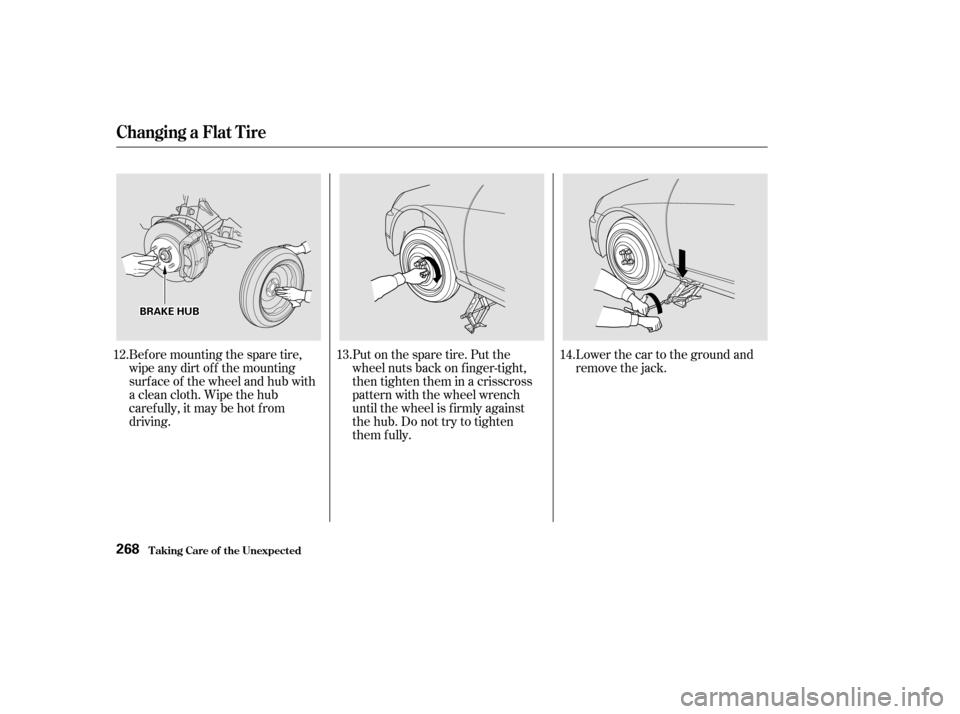
Lowerthecartothegroundand
remove the jack.
Put on the spare tire. Put the
wheel nuts back on f inger-tight,
then tighten them in a crisscross
pattern with the wheel wrench
until the wheel is f irmly against
the hub. Do not try to tighten
them f ully.
Bef ore mounting the spare tire,
wipeanydirtoff themounting
surface of the wheel and hub with
a clean cloth. Wipe the hub
carefully,itmaybehotfrom
driving.
12. 13.
14.
T aking Care of t he Unexpect ed
Changing a Flat T ire
268
BBRRAAKKEEHHUUBB
Page 268 of 319
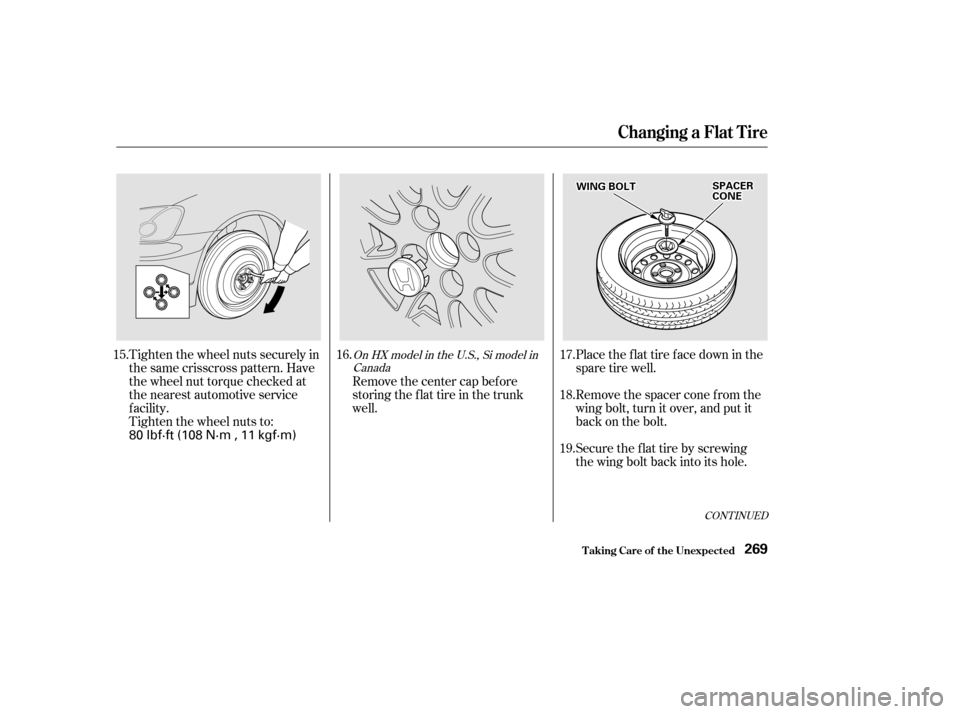
Tighten the wheel nuts securely in
the same crisscross pattern. Have
the wheel nut torque checked at
the nearest automotive service
f acility.
Tighten the wheel nuts to:Place the flat tire face down in the
spare tire well.
Remove the spacer cone f rom the
wing bolt, turn it over, and put it
back on the bolt.
Secure the f lat tire by screwing
the wing bolt back into its hole.
Remove the center cap before
storing the f lat tire in the trunk
well.
15. 16. 17.
18. 19.
CONT INUED
On HX model in the U.S., Si model inCanada
Changing a Flat T ire
T aking Care of t he Unexpect ed269
WWIINNGGBBOOLLTTSSPPAACCEERRCCOONNEE
80 lbf·ft (108 N·m , 11 kgf·m)
Page 269 of 319

Store the jack in the trunk with the
end bracket on the lef t side. Turn
the jack’s end bracket to lock it in
place. Store the tool kit.
Store the wheel cover in the trunk.
Make sure it does not get
scratched or damaged.
Lower the trunk f loor, then close
the trunk lid.
20.
21.
22.
Changing a Flat T ire
T aking Care of t he Unexpect ed270
Loose items can fly around the
interior in a crash and could
seriously injure the occupants.
Store the wheel, jack, and tools
securely before driving.
Page 270 of 319

Diagnosing why your engine won’t
start f alls into two areas, depending
on what you hear when you turn the
key to START (III):When you turn the ignition switch to
START (III), you do not hear the
normal noise of the engine trying to
start. You may hear a clicking sound
or series of clicks, or nothing at all.
Check these things:
You hear nothing, or almost
nothing. The engine’s starter
motor does not operate at all, or
operates very slowly.
You can hear the starter motor
operating normally, or the starter
motor sounds like it is spinning
f aster than normal, but the engine
does not start up and run. Check the transmission interlock.
If you have a manual transmission,
the clutch pedal must be pushed
all the way to the f loor or the
starter will not operate. With an
automatic transmission, it must be
in Park or Neutral.
Turn the ignition switch to ON (II).
Turn on the headlights and check
their brightness. If the headlights
are very dim or don’t light at all,
the battery is discharged. See
on page . Turn the ignition switch to START
(III). If the headlights do not dim,
check the condition of the f uses. If
the f uses are OK, there is proba-
bly something wrong with the
electrical circuit f or the ignition
switch or starter motor. You will
need a qualif ied technician to
determine the problem. (See
on page .)
If the headlights dim noticeably or
go out when you try to start the
engine, either the battery is dis-
charged or the connections are
corroded. Check the condition of
the battery and terminal connec-
tions (see page ). You can
then try jump starting the car from
a booster battery (see page ).
273 230
273289
Nothing Happens or the Starter
Motor Operates Very Slowly
Jump Starting Emergency T owing
If Your Engine Won’t Start
T aking Care of t he Unexpect ed271